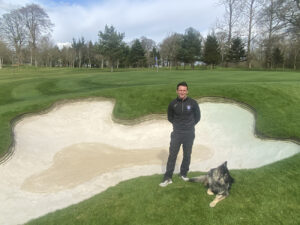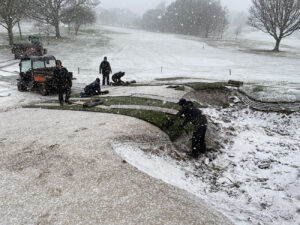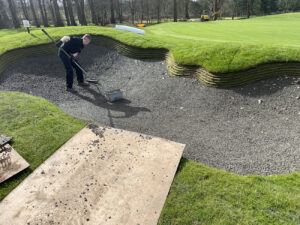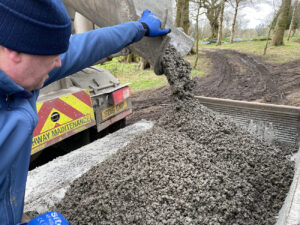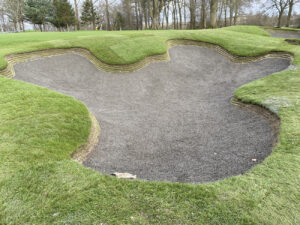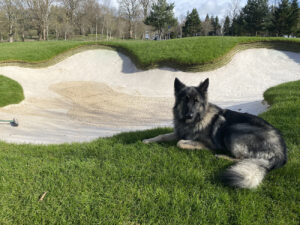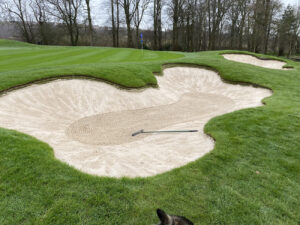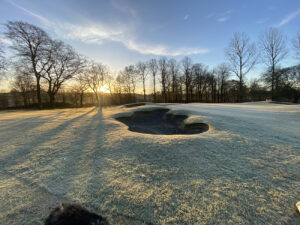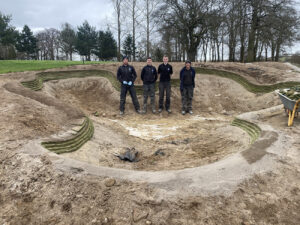Meet the golf course manager: Paul Hempsey
Related Articles
From Glasgow Golf Club, Paul Hampsey details a career that has seen him redesign a signature hole and how the bunkers at his current, historic course have been given a modern and spectacular upgrade.
Glasgow Golf Club is unique in the world of golf.
Founded in 1787, it is thought to be the ninth oldest golf club in the world, and has two highly-rated courses, one parkland and the other a links – some 35 miles apart.
Here, the club’s golf course manager, Paul Hampsey, talks about his career to date and the bunkers that are being revamped at the parkland facility. just five miles from Glasgow’s city centre.
Could you tell us about how you got into greenkeeping and your development in the profession?
I got into greenkeeping in the late 1990s, when a lifelong friend bagged an apprenticeship at our local moorland course, Gourock Golf Club, 30 minutes west of Glasgow. He mentioned there was a seasonal greenkeeper vacancy there which I gladly filled. The friend, Robert Cleisham, has also carved a very successful career and is now leading the team as course manager at Stockport Golf Club.
I didn’t go in with any long-term vision but I quickly recognised that there was a lot more to the job than I expected, and knew after a couple of weeks that I wanted to pursue a career in this industry. I threw myself into the temporary position in the hope the club wouldn’t look past me in the future. Hugh Logue, who was, and still is, course manager there, quickly recognised how much I applied myself. He approached the club to take me on as a second apprentice, and it was my first break. I’m still in regular contact with Hugh and I learned so much from him over the years.
Gourock under Hugh was the best possible learning curve. It’s my home club in the west of Scotland and it must be the wettest part of the country. On the banks of the Clyde in particular they regularly record more than two metres annually! Hugh was ahead of his time and put forward a long-term plan to reconstruct all 18 greens to almost USGA spec, and to reconstruct the closest set of tees at the same time – turf removed, sub soils removed, new drainage installed, gravel raft carpet and 70/30 rootzone profile. One green per year was the plan and all work was to be undertaken in-house by Hugh and his team.
This was a great springboard for me. Taking that level of construction on so early in my career really opened my eyes and inspired me to move on in my career with confidence in most aspects of the job. Since then, Gourock now has all 18 greens close to USGA spec, which in my opinion will safeguard the club’s biggest asset for many years to come. It’s a great achievement which should be commended.
I spent almost five years at Gourock before I made the move across Clyde to Cowal Golf Club as first assistant, aged 21. Less than one year later I became head greenkeeper. I must have been one of the youngest head greenkeepers in the country at that point and I thought I had made it! It wasn’t plain sailing with a small team of four, one assistant greenkeeper, one apprentice and one young first assistant who I had just promoted at the end of his apprenticeship, Steven Willson, who had a massive impact on my career later. We worked tirelessly making some changes to the presentation with additional drainage works to some historical problematic areas.
Every year the budget got tighter; add into the mix a few consecutive wet summers and dwindling membership and things became difficult. There was always talk of a housing development and the promise of a major turnaround, but it never materialised and I felt I had stayed too long and now ten years had gone by. It’s not easy to get a move in this game when you are coming out of a struggling golf club, I can testify to that! I started to think maybe greenkeeping wasn’t going to work out after all and was looking at other options in other industries. I had good offers but couldn’t bring myself to leave greenkeeping.
One day I received a phone call from Stevie Willson, who had moved on ten years before me. We always kept in contact and he was forever encouraging me to move on, as I had with him years before. Stevie progressed to different courses across the country, including the home of golf, St. Andrews and the Dukes, and he was now newly promoted to head greenkeeper of the new course in Balmedie Aberdeen: Trump International. He asked me if I would consider a move to Aberdeen to join him as his first assistant, to help him manage a team of 15 greenkeepers under links superintendent, John Bambury. By now I was happily married, with three kids all settled into a life with a big family around us, but I had to take this opportunity!
My wife and I agreed that I should move there for six to 12 months, coming home every second weekend. Driving away from my young family once a fortnight, knowing it would be at least that until I saw them again, was the hardest thing I’ve done in my life.
After a brilliant year working under John, he decided he now had a team he could leave in place to continue his good work while he moved on. Stevie was promoted to links superintendent, and I to head greenkeeper. I now had to make the dreaded call to my poor wife to say she and my kids should now look to come and join me and leave everything she knew, including her job! She reluctantly agreed because I promised that this job would open up so many doors to clubs back home and we won’t be there longer than five years. I just about kept my word as we approached the five years when I took the position as course manager at East Renfrewshire Golf Club.
Before I go on, I must give mention to Stevie and the team at Trump for resuscitating my career. It was a great experience working on one of the highest standards of golf courses in the country, with free draining links sand lands, and all the resources you need and more. It was surreal to me at first. And the golf course design, wow! It is a complete masterpiece from Dr Martin Hawtree. Working there and being a big part of the management team was a privilege. My love for greenkeeping was reformed on a completely different level. If there is one thing that really developed there for me I would have to admit to it being the art of application and calibration. In general, my agronomical understanding was taken to new levels. I took it all on board and went on to develop my own set of standards and practice.
You led an ambitious programme of redevelopment at East Renfrewshire. How did you go about this?
When I was introduced to East Renfrewshire GC I was immediately drawn to its natural and unique layout, it’s a moorland course, as is Gourock, with some stunningly good undulating natural terrain. The course had had very little investment or development in recent years but I had a vision for the development of the course immediately, and I felt the board there would support me.
I assessed the course and identified a number of features to consider for improvement but greens drainage was going to take priority. Bunkers had next to no drainage, some would fill up like water features, while the others would be left with no sand on the faces after heavy rain, and with no liner at all, the debris and stone contamination was the worst I had seen.
There were a lot of small tee boxes which were very beaten up and uneven.
I considered the best course of action for greens drainage would be to invest in USGA spec greens reconstruction but that wouldn’t leave much financial scope to develop beyond that, which didn’t make sense considering all improvements required. I developed a long-term plan which involved upgrading two holes per year, full pipe drainage installation, tying into new bunker drainage and surrounds if required. I decided we should have steep bunker sand faces with a six-stack natural revetted edge, for sharp definition. We would also drain and level tee boxes, and re-turf with a rye fescue mix.
As we were on moorland, I decided to try and slab the tee banks with some natural vegetation, a mix of heather and tall fescues and so on, to try and give a more natural look but also reduce our maintenance. We then began to do the same on the long carries from tees to fairways and it worked tremendously well. I sourced a contact to get a full 3G football pitch of artificial turf and we began a programme to lay as much of it as required around the course for golf buggies to continue around the course, particularly in the winter months. The board gave me unbelievable support, and we committed to the plan. After year one it was already proving to be the way to take the course direction forward.
In year two, I came up with a new design to remodel the short 120-yard par three. Drainage was a priority again, but I felt this hole could be a signature hole, with the green high up on the top of the hillside with three bunkers positioned in front of the green.
I levelled all three bunkers and built four beautiful new CapillaryFlow bunkers, pushed them front left and right and middle left and right. On completion, the hole was almost unrecognisable and the members there really love what we achieved.
After your success at East Renfrewshire, what made you move on to Glasgow Golf Club? What size is your team there?
I was fully committed to East Ren and could have seen myself there for many years. However, Glasgow is a club steeped in history. I couldn’t ignore the fact that the course manager’s job had become vacant. My former general manager at East Ren, who I had a great working relationship with, had just moved there. I applied out of interest to see what the club’s plans were. I knew that Stuart Taylor and his team there had kept the course at Killermont to a great standard for many years, so I wasn’t sure if I could take the course forward. I looked beyond the condition of the course and considered its features, and as it is a parkland course the obvious big feature is the ancient trees that line the fairways. They really are majestic! I could see an opportunity to enhance the course with some new bunker design trials, so I took on the role here in 2021.
At the moment there are seven of us working full time on the team, short of the nine we are looking to recruit. It’s an exciting time to be at Glasgow GC and feel very privileged to have the responsibility to develop the team and course here at Killermont Glasgow GC.
The club is the ninth oldest in the world and the current course design originated in the early 20th century, what is the trickiest aspect of the course for your team to maintain?
We are very proud that we still have the original Old Tom Morris layout. Having said that, we are a very tight site, just under 58ha plus 8ha of practice field, and we are looking to develop this for improved practice facilities. I always try to look beyond the layout for alternatives in teeing and pathways but that is not easy on such a tight site. I would say our biggest challenge is negotiating golf traffic management and spreading the wear on the course. We have already installed some artificial second-hand turf down on four new walkways which are proving to be successful additions.
What do you enjoy most about your job and what has been your biggest challenge to date?
I love that we have a wide range of elements to manage. A golf course is a living organism and we are often trying to manipulate its form. I take great satisfaction when we maximise the work we do in weather windows. There is no more satisfaction than seeing our winter projects coming together in play during the season. I also like the challenge of targeting major events in the calendar throughout a season in which we plan to hit peak condition. When that comes to fruition there can’t be much more sense of achievement for me.
The best thing about the job is that there is no right or wrong way to achieve results; it’s all about you and your team’s experience combined, so it’s a true team game. I take great pride in seeing the team pulling together, especially in times when there is pressure and timescales.
What has been your proudest achievement in the job so far?
I think my proudest achievement would have to be finding the course at East Ren in need of development direction, putting a team in place with a long term plan, getting that development in motion, seeing the improvements being received by members and then seeing the team I put in place continuing to take the course forward with their own version of methods and practice. I would say that is some form of legacy for me, or at least I’m claiming it!
Have you been affected by extreme weather conditions such as drought, flooding or heavy snow recently, if so how have you coped with that?
This winter for me has been a strange one; I can’t remember a winter with such quick fluctuations in temperature. One day recently it was minus five in the morning with clear skies and by the afternoon we had floods and mild temperatures. It has been a struggle to plan spray and sand applications.
You’ve installed Capillary Bunkers on the course at Glasgow. Why did you choose this system and how have Capillary Bunkers made a difference?
I first decided to trial CapillaryFlow as a liner when I worked at East Renfrewshire. It was a fairly new concept to the Glasgow area at the time and using concrete as a liner did raise some eyebrows! I had done my research, however, and the 10-year warranty offered by Border Sports helped me feel confident to trial it. I chose this method as I felt it would be the best to hold the sand up while still being free draining, but also retain some moisture in the dry spells. It is a tremendous product! I used it for the three years of bunker development, nine bunkers in total.
Maintenance of the new Capillary Bunkers was nothing in comparison to the old bunkers and it made a big difference to us.
When I moved to Glasgow GC in 2021, I could see the opportunity for bunker renovations to improve things. The old design had worked well for some 25 years, with really eye-catching grass catchment banks leading into flat pan bunker sand. A lot of the feedback from members had been that balls were getting lipped up on the edge. I decided to trial a new bunker design with two main concepts; bring sand high up the faces so we could get a sort of 3D visual effect and see the bunkers from distance, and to bowl out the base so as to encourage the balls into the middle of the bunkers for a fair exit shot. As we could take this work on in-house, I decided that we should maximise the quality of liner and edging, so we decided we would have a go at the ‘gold standard’ combination of CapillaryFlow sealed with eco revett wall edges.
In the first year we trialled two green-side bunkers at our par four 3rd and this year we took on two holes, all four at the par 3 11th green side. All had serious drainage issues beforehand. They haven’t been in play for long but there is no doubt we achieved a much-improved aesthetic design which really enhances the approach visuals. It remains to be seen if we have nailed the playability aspect of the design, but early signs and feedback are good.
How many bunkers have you installed Capillary Bunkers on? Was the installation process straightforward?
We’ve done eight so far here at Glasgow GC. Working alongside Neil at Border Sports has made the installation a pleasure as he is very experienced in this field and does a fine job working alongside the team until you feel confident enough to take them on by yourself. CapillaryFlow installation is one of those days in the year when there is a bit of pressure on, to have everything in place and to be as productive as possible so the loaders are not sat on site for too long. The team and I get a bit of a buzz out of that kind of pressure and the end results are very satisfying.
What advice would you give to anyone hoping to follow the same career path as you?
I will say the same thing as I do to my young staff: always study everything and everyone around you, team mates, associates, reps and of course bosses. Look at how they interact and note the impact that has on others, positive and negative, take mental notes to try to develop the positives and leave the negative behind. Assess the actions and words of others and consider if you could negotiate it better if you were in that position.
Go to as many job interviews as possible, even if you aren’t so fussed to get the job, you will sense the things that have positive effects and the negative, and when the time comes for the job you really want, you will ultimately be much more confident to provide a polished version of presentation, as you will have left behind the things that didn’t work from previous interviews and push the positives.
Try and gain as much tournament experience as possible. I’ve yet to meet someone who has a lot of tournament experience and not gone on to forge a good career in the game.
If you don’t see any progression in a job, then force progression.
Apply yourself so you can’t be ignored, or move on. Don’t look at other courses with envy, go and get that job. I guarantee if you keep approaching the same employer you wish to work for, and your reputation is good, you can’t be ignored for long!
For more information, visit www.bordersportsservices.co.uk

